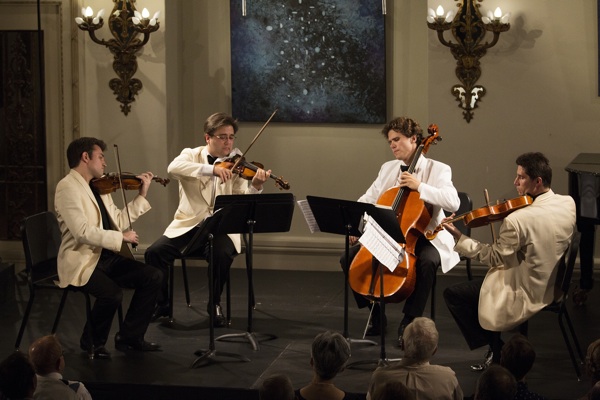Proclaiming a milestone in Menlo Park
As part of the Dvořák fest at Music@Menlo’s summer music festival, the Escher Quartet performed all four string quartets of Alexander Zemlinsky. This remarkable feat was done in one long evening, Wednesday, July 23, but took us on a far longer journey – from the late nineteenth century of Brahms’ lush Romanticism into the slippery twentieth century textures and tone rows of Schoenberg and Berg.
After an evening that began with a free “Prelude Performance” with remarkably accomplished younger musicians, this concert took it up a notch.
From the first tight chords it was apparent that the Escher Quartet has a unity that could be evidence of telepathy. And even if they do happen to share a hive mind, these four young men are separately gifted. We felt blessed to witness a most singular conjunction of ferocious focus, deep understanding of late Romantic material, and work that spanned an extraordinary era.
And that is an even larger story. Besides the superb playing of the Escher Quartet, their slow evolution of styles through the four works described a changing worldview, a shifting of certainties. And beyond even that, there was a sense that this was truly personal material, eliciting a personal experience from the audience. (One could see looks of surprise and wonder, and afterwards, they dragged the performers back with shouts and rhythmic clapping.)
These were indeed personal. The first quartet, written in 1896, was an homage to Brahms. After hearing it, Brahms critiqued the quartet and offered Zemlinsky a stipend so that he could spend more time composing. First violinist Adam Barnett-Hart used “hiccups” in his bowing to surge ahead and then wait up for his friends, harnessing a youthful ardor with affectionate restraint.
This was hugely done, setting us firmly in a worldview that still believed in the process, a world of late Romantics and Transcendentalists, sunny and florid, stately and lyrical, all grouped around sumptuous accords.
 The second quartet is dedicated to Schoenberg, his former student and then his brother in law – he married Zemlinsky’s sister, Mathilde. Written in 1913, it uses an atonal language, slippery and somber and questioning.
The second quartet is dedicated to Schoenberg, his former student and then his brother in law – he married Zemlinsky’s sister, Mathilde. Written in 1913, it uses an atonal language, slippery and somber and questioning.
Music@Menlo offers “Audio Notes” to all of its ticket buyers, an awesome educational opportunity that can be heard online before concerts. In one of those, violist Pierre LaPointe discussed the depth of the quartets with long-time Education Director Patrick Castillo.
“All throughout the piece the cello represents Schoenberg and the viola represents Mathilde, just like in Verklärkte Nacht, which Schoenberg wrote for Mathilde. And the second violin embodies the concept of reconciliation.”
This quartet, written on the verge of World War I, has a welter of feelings. The viola is gorgeous here, seasick and rudderless over throbbing cello notes. There is an uncertain beauty, with the violin part high and thin and irresolvable, and then acerbic harmonic backdrops that could have inspired Shostakovich and Crumb. Tonality was sliding away, like the galvanic shifting of their society.
Reflecting their personal traumas, Zemlinsky’s sister had an affair with the artist who was teaching Expressionist art to her and her husband, Schoenberg. Fellow composer Alban Berg helped them to reconcile for the sake of their children, but that painter, Gerstl, committed suicide, and Mathilde seldom spoke again. Beyond that strained reunion, Zemlinsky himself had fallen in love with his student, Alma Schindler. After she rebuffed him to marry composer Gustav Mahler, Zemlinsky’s composing never again captured the sunny faith of Brahms.
Somehow all of that angst translated into music. And such sublime music! Searing lyricism and a sadness at the center of the world. Over all these messy emotions is stretched a careful architecture which even includes numerology. In the eye-opening program notes by Andrew Goldstein, he describes how Zemlinsky chose a three-note motif to represent himself – deriving from a falsified birth date! – of the second, third and fifth notes of a major scale. Curiously, his motif of the cosmos is the inversion of the self motif, where external and internal become mirrors. Most prominent in the first quartet, we could hear it recurring throughout his work and life. Deep!
The third quartet, written in 1924 as a requiem for Mathilde, was all quick gestures and loamy accords with an emphasis on the viola’s throaty and interior voice. After a tearful Romanze came a bitter Burlesque, with cellist Dane Johansen excelling in rich tones and moments of madness.
And the final quartet? Subtle and far-reaching and, again, so personal. This was also his memorial to Alban Berg. If it were just a little easier to play, Zemlinsky could have been a household name. Championed by the Escher Quartet, which just published these on Naxos, he will hopefully now begin to get his due.
Music@Menlo continues through August 9 with a wealth of concerts and lectures. Coming up this Thursday is “American Visions,” July 31 at 8 p.m., and “Transitions” on August 1 and 2 at 8 p.m. and free concerts can be heard at 5:30 p.m. each evening. See musicatmenlo.org for complete notes and tickets.
—Adam Broner
Photo of the Escher Quartet, from left: Adam Barnett-Hart, Aaron Boyd (violins), Pierre Lapointe (viola), and Dane Johansen (cello); photo by Tristan Cook.
